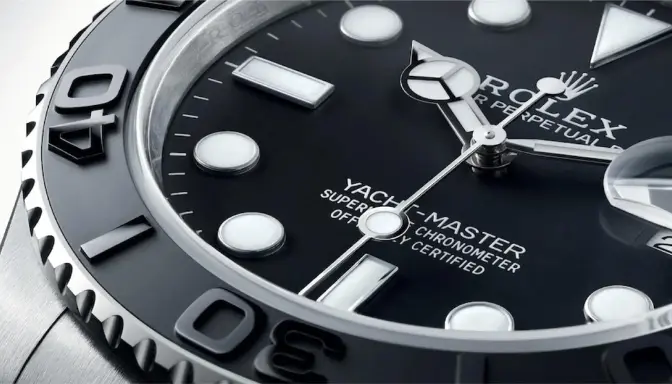The Yacht-Master II is powered by the calibre 4161, a self-winding mechanical movement that incorporates the Ring Command system, which allows the user to activate and adjust the countdown function by rotating the bezel. The movement also has a column wheel and a vertical clutch, which ensure a precise and smooth start and stop of the chronograph. The movement has a power reserve of approximately 72 hours, and is certified as a Superlative Chronometer by Rolex and the COSC.
The Yacht-Master II is available in different combinations of materials and colors, such as:
- Oystersteel: with a steel bezel, case, and bracelet. The dial can be white or blue, with red and blue accents.
- Everose Rolesor: a combination of Oystersteel and 18 ct Everose gold, with an Everose gold bezel and a steel and Everose gold case and bracelet. The dial can be white or blue, with red and blue accents.
- Yellow gold: with a yellow gold bezel, case, and bracelet. The dial can be white or blue, with red and blue accents.
- White gold: with a white gold bezel, case, and bracelet. The dial can be white or blue, with red and blue accents.
The Yacht-Master II is a watch that demonstrates the technical mastery and innovation of Rolex, and the passion and excitement of yacht racing. It is a watch that offers a unique and sophisticated function, with a bold and distinctive design.
The History of the Yacht-Master

The Yacht-Master is a relatively young model in the Rolex family, as it was introduced in 1992, more than 40 years after the first Rolex watch dedicated to sailing, the Submariner. However, the Yacht-Master has a rich and fascinating history, as it is the result of decades of research and development, and of close collaboration with the sailing community.
The origins of the Yacht-Master can be traced back to the 1960s, when Rolex experimented with a new model called the Sea-Dweller, which was designed for professional divers who needed a watch that could withstand extreme depths and pressures. The Sea-Dweller had a helium escape valve, which allowed the excess gas to escape from the watch during decompression, and a thicker case and crystal, which increased the water resistance to 610 metres (2,000 feet).






